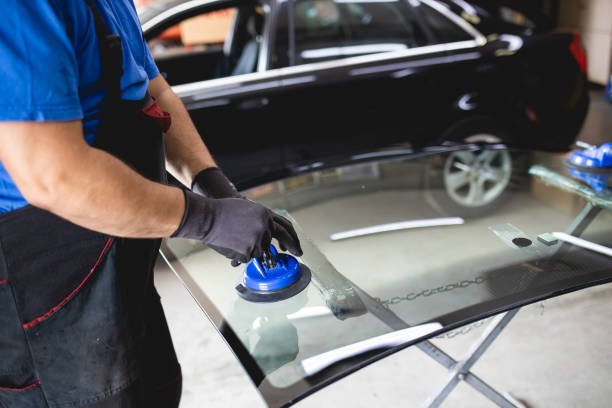1. Road Debris and Gravel
One of the most common reasons for windshield cracks is debris from the road, especially small rocks or gravel. These can be kicked up by the tires of other vehicles, especially trucks, and hit your windshield with enough force to cause chips or cracks. Highways and construction zones are especially risky for this type of damage due to the increased presence of loose materials on the road.
How to Prevent Cracks from Road Debris
While you can’t entirely avoid road debris, there are ways to reduce the risk:
Maintain Distance: Keep a safe distance from large vehicles, particularly trucks and construction vehicles, as they are more likely to kick up rocks.
Avoid Construction Zones: If possible, take alternate routes around construction areas where gravel and other materials are often present.
Drive at a Moderate Speed: High speeds increase the impact of debris on your windshield. By slowing down, especially in risky areas, you reduce the likelihood of cracks.
Following these tips can help minimize the chances of road debris causing windshield damage.
2. Sudden Temperature Changes
Windshields are made from tempered glass, which is sensitive to sudden temperature fluctuations. If a windshield is exposed to extreme heat or cold and then exposed to the opposite temperature, it can cause the glass to expand or contract rapidly, leading to cracks. For example, pouring hot water on a frosted windshield or blasting the defroster on a hot day can create enough stress to cause cracking.
How to Prevent Temperature-Related Cracks
Protecting your windshield from sudden temperature changes is essential. Here’s how:
Warm or Cool Gradually: Use the defroster gradually to warm a cold windshield instead of setting it to the highest heat immediately.
Avoid Extreme Solutions: Avoid pouring hot water or ice directly on the windshield. These methods can weaken the glass and make it prone to cracking.
Park in Shade or Garage: When possible, park your vehicle in a garage or shaded area to avoid direct exposure to extreme weather.
By adjusting your practices, you can protect your windshield from damage caused by abrupt temperature shifts.
3. Poor Installation or Low-Quality Glass
Improper installation or low-quality replacement glass can lead to cracks over time. When a windshield is not installed correctly, it may not have the necessary support or may be more susceptible to stress from vibrations or pressure. Additionally, low-quality glass can have impurities or weaknesses that make it more vulnerable to damage, increasing the risks of ignoring windshield cracks and leading to further issues down the road.
How to Prevent Cracks Due to Poor Installation
Ensuring quality installation and glass is essential for a durable windshield. Here’s what to do:
Choose a Reputable Installer: Always use a certified and experienced professional for windshield installation or replacement.
Ask for OEM Glass: Original Equipment Manufacturer (OEM) glass is designed to match your vehicle’s specifications, offering better quality than some aftermarket options.
Inspect the Windshield Post-Installation: After installation, inspect the windshield for any gaps or uneven positioning. If anything seems off, ask the installer to correct it.
Using high-quality glass and ensuring proper installation can prevent future cracks and increase the lifespan of your windshield.
4. Pressure Changes and Stress
Pressure changes, such as those from slamming car doors or going over large potholes, can put stress on the windshield, leading to cracks. Windshields are designed to handle regular driving conditions, but extreme impacts or vibrations can create small fractures that eventually grow into larger cracks.
How to Prevent Cracks from Pressure and Stress
Minimizing stress on your windshield can reduce the risk of pressure-related cracks. Here are a few ways to do this:
Close Doors Gently: Avoid slamming doors as it sends a shockwave through the car, which can impact the windshield.
Drive Carefully on Rough Roads: Slow down on uneven or bumpy roads to prevent harsh jolts and vibrations that put stress on the glass.
Avoid Parking on Uneven Surfaces: When possible, park on level ground to reduce stress on the windshield that can arise from uneven pressure distribution.
By being mindful of how your driving habits impact the windshield, you can avoid the gradual wear that leads to cracks.
5. Sunlight and UV Rays
Extended exposure to sunlight can weaken the windshield, especially in hot climates. UV rays can cause the glass to expand and contract, which gradually creates small fractures. Over time, these fractures can grow into visible cracks. Additionally, sunlight can deteriorate the adhesive that holds the windshield in place, making it more susceptible to cracks.
How to Prevent Sunlight-Related Cracks
Protecting your windshield from prolonged sunlight exposure is essential, especially in warmer months. Here’s how to do it:
Use a Windshield Sun Shade: A sunshade helps block UV rays and keeps the interior cooler, which can prevent the glass from expanding excessively.
Park in the Shade or Use a Car Cover: Parking in a shaded area or using a car cover helps minimize exposure to direct sunlight, reducing the chance of sun-related cracks.
Apply a UV-Protective Film: Some protective films can be applied to the windshield to filter out harmful UV rays and reduce heat buildup, helping prevent cracks.
Taking these steps can protect your windshield from the cumulative effects of sunlight and UV rays.
